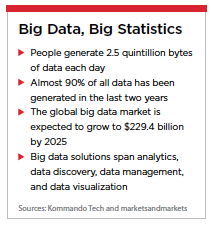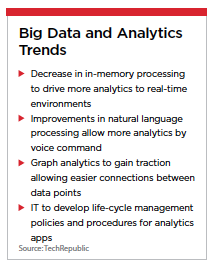Big data is big business, and for the life-sciences and healthcare industries it’s playing an important role in informing everything from R&D to commercialization.
With the growth of digital healthcare, it is estimated that the amount of data the industry is collecting is increasing by around 50% per year. The healthcare and life-sciences industries have recognized that data is an asset in their organizations.
According to reports, the global big data healthcare market is predicted to be valued at $67.82 billion by 2025. ICH Health Insights predicts that by 2022, 30% of life-sciences companies will have achieved data excellence, using the right data at the right time to assist with decision-making. Most important, companies are increasingly focused on data that is fit for purpose and that allows them to glean actionable intelligence.
Big Data Across the Enterprise
 Almost every aspect of the industry stands to gain from big data. In R&D, big data can give companies better insights into drugs and their usage and can also be leveraged for predictive modeling, for example to predict drug interactions and toxicity. Data gathered from previous clinical studies and post-marketing surveillance can also provide insights into whether regulators will give a product approval as well as likely patient outcomes.
Almost every aspect of the industry stands to gain from big data. In R&D, big data can give companies better insights into drugs and their usage and can also be leveraged for predictive modeling, for example to predict drug interactions and toxicity. Data gathered from previous clinical studies and post-marketing surveillance can also provide insights into whether regulators will give a product approval as well as likely patient outcomes.
Novartis, which has developed a platform called Nerve Live, uses technology advances to help the company leverage its huge data pool in order to research and develop new therapies. To achieve this goal, the team built a data lake and then created an advanced analytics engine to process the data. By applying machine learning and cognitive computing algorithms, users can gain insights that can help with better, more informed, decision-making.
Clinical trials have always depended on data; now with wearables, companies can potentially get rich new datasets and gain deeper insights. According to clinicaltrials.gov, as of February 2020, there were 460 wearable studies underway, and other researchers maintain as many as 70% of trials will incorporate sensors by 2025. These large datasets will let companies enhance their studies as well as the products they develop.
Another way big data can assist with clinical trials is in helping to determine the right patient for any given trial.
In the supply chain, where cold chain management is essential for some products, companies need key data, such as temperature and humidity along with tracking data to support decisions about the supply chain.
Big data is playing an important role in regulatory decision-making. A Heads of Medicine (HMA) European Medicines Agency (EMA) task force has set out recommendations for understanding how big data can be used in the evaluation of medicines. The task force began with establishing a definition of big data, which reads: “extremely large datasets [which] may be complex, multi-dimensional, unstructured, and heterogeneous, which are accumulating rapidly and which may be analysed computationally to reveal patterns, trends and associations. In general, big data sets require advanced or specialised methods to provide an answer within reliable constraints." The agency has recognized that big data will be used more frequently by regulators to assess the benefit-risk of medicines.
Data from social media forums and medical forums, meanwhile, can be mined for insights on adverse drug events and patient concerns.
 And big data is also playing an important role in commercial decision-making, with business leaders using it to assess customer behaviors, the effectiveness of advertising and marketing campaigns, and what steps to take to improve customer retention. Companies increasingly recognize that big data can help them understand the market and use that knowledge to determine product demand and product budgets.
And big data is also playing an important role in commercial decision-making, with business leaders using it to assess customer behaviors, the effectiveness of advertising and marketing campaigns, and what steps to take to improve customer retention. Companies increasingly recognize that big data can help them understand the market and use that knowledge to determine product demand and product budgets.
Big Data and Precision Medicine
Among the most important areas in the industry today are precision medicine and personalized care. In this area, big data can assist a company to qualify a drug for a patient based on their genetics, diseases, and even lifestyle. With information about how drugs work based on the specific patient, companies can work more collaboratively with physicians by helping them understand how a medication might assist their patient based on that person’s genetics.
Bioinformatics company NuMedii has been bringing together big data, artificial intelligence, and systems biology for more than a decade with the objective of accelerating precision medicine discoveries. The company’s AIDD (artificial intelligence for drug discovery) technology extracts information from multiple disparate data sources to find connections between drugs and diseases.
Another bioinformatics company, Deep Genomics, has developed AI learning methods to find patterns from massive datasets and develop computer models to find drug candidates for genetic diseases.
The advent of high-throughput of next-generation sequencing is helping to advance genomic research by producing billions of short DNA or RNA fragments that create massive datasets. Big data algorithms are being put to use to allow researchers to assess this data and link genes to specific diseases.
Pharma.AI, a division of Insilico Medicine, is developing deep learned biomarkers of multiple diseases, predictors of different therapeutic uses of multiple drugs, and analytical tools for high-throughput screening.
Among the many pharmaceutical companies working in this area is Roche, which has invested in bioinformatics. Its division Roche Sequencing Solutions has authored multiple algorithms to help distinguish true mutations with a goal of using this knowledge to develop precise treatments in the future.
The importance of big data is the ability to take structured and unstructured data and turn it into actionable information and insights. Across the enterprise, big data has the potential to result in business improvements as well as cost savings, assisting with drug design, trial design, trial insight, product review, and safety oversight, as well as managing the supply chain. Properly leveraged and used, big data can be a true game-changer.(PV)
~~~~~~~~~~~~~~~~~~~~~~~~~
Big Data, Big Statistics
People generate 2.5 quintillion bytes of data each day
Almost 90% of all data has been generated in the last two years
The global big data market is expected to grow to $229.4 billion by 2025
Big data solutions span analytics, data discovery, data management, and data visualization
Sources: Kommando Tech and marketsandmarkets
~~~~~~~~~~~~~~~~~~~~~~~~~
Big Data and Analytics Trends
Decrease in in-memory processing to drive more analytics to real-time environments
Improvements in natural language processing allow more analytics by voice command
Graph analytics to gain traction allowing easier connections between data points
IT to develop life-cycle management policies and procedures for analytics apps
Source: TechRepublic
~~~~~~~~~~~~~~~~~~~~~~~~~
Executive viewpoints
 Brigham Hyde, Ph.D.
Brigham Hyde, Ph.D.
President, Data and Analytics
EVERSANA
Using Big Data to Inform Strategies from R&D to Commercialization
It’s really simple, data analytics drives decisions. We use data to better understand the complexity of disease, improve forecasting and communications with patients, design more effective clinical trials, predict trends, and customize treatment pathways. Global data and analytics have the power to address critical challenges and demonstrate the value of interventions. Integrating data and analytics within your patient-services care model improves effectiveness in mobilizing your salesforce, building distribution strategies, and achieving stakeholder intimacy.
Cutting-edge Analytics, Processing, and Query Technologies Are Influencing Decision-Making
Predictive analytics and machine learning have the potential to transform healthcare by putting prediction and “next best action" at the core of everything we do. Whether reducing real world data (RWD) analysis time from days to minutes, integrating AI into patient and hub services to improve adherence, or identifying misdiagnosed patients in rare or complex conditions, we have the ability to identify trends, and predict events that create real value for millions of patients worldwide.
 Angelo Campano
Angelo Campano
Senior VP, Point of Care Practice (EHR/ABM)
Ogilvy Health
Found Knowledge
We often talk about big data from large HCOs and their technology (such as their EHR), and its use on new response channels that can be stored in our database to help us understand not only what the value of the customer is, but also which part of the customer lifecycle to target, and what that customer’s significance is to our business. These bits of found knowledge are important insights that can be made usable by marketing analytics as well as by any type of strategy, and they really do accrue value over time.
 Lisa Green
Lisa Green
VP, Medical Director
Ogilvy Health
Amplify the Strategy
The breadth, depth, and speed of big data are enticing and can augment many aspects of pharmaceutical development. Providing timely information and insights access in understandable formats to the various teams along the continuum should amplify a company’s strategy. That said, big data may at present best be used for projects with well-defined focus that have the flexibility for integration of results from real-world validation.


















